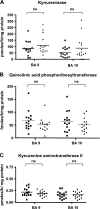Impaired kynurenine pathway metabolism in the prefrontal cortex of individuals with schizophrenia
- PMID: 21036897
- PMCID: PMC3196941
- DOI: 10.1093/schbul/sbq112
Impaired kynurenine pathway metabolism in the prefrontal cortex of individuals with schizophrenia
Abstract
The levels of kynurenic acid (KYNA), an astrocyte-derived metabolite of the branched kynurenine pathway (KP) of tryptophan degradation and antagonist of α7 nicotinic acetylcholine and N-methyl-D-aspartate receptors, are elevated in the prefrontal cortex (PFC) of individuals with schizophrenia (SZ). Because endogenous KYNA modulates extracellular glutamate and acetylcholine levels in the PFC, these increases may be pathophysiologically significant. Using brain tissue from SZ patients and matched controls, we now measured the activity of several KP enzymes (kynurenine 3-monooxygenase [KMO], kynureninase, 3-hydroxyanthranilic acid dioxygenase [3-HAO], quinolinic acid phosphoribosyltransferase [QPRT], and kynurenine aminotransferase II [KAT II]) in the PFC, ie, Brodmann areas (BA) 9 and 10. Compared with controls, the activities of KMO (in BA 9 and 10) and 3-HAO (in BA 9) were significantly reduced in SZ, though there were no significant differences between patients and controls in kynureninase, QPRT, and KAT II. In the same samples, we also confirmed the increase in the tissue levels of KYNA in SZ. As examined in rats treated chronically with the antipsychotic drug risperidone, the observed biochemical changes were not secondary to medication. A persistent reduction in KMO activity may have a particular bearing on pathology because it may signify a shift of KP metabolism toward enhanced KYNA synthesis. The present results further support the hypothesis that the normalization of cortical KP metabolism may constitute an effective new treatment strategy in SZ.
Figures






References
-
- Pakkenberg B, Scheel-Krüger J, Kristiansen LV. Schizophrenia; from structure to function with special focus on the mediodorsal thalamic prefrontal loop. Acta Psychiatr Scand. 2009;120:345–354. - PubMed
-
- Tan HY, Callicott JH, Weinberger DR. Dysfunctional and compensatory prefrontal cortical systems, genes and the pathogenesis of schizophrenia. Cereb Cortex. 2007;17(suppl 1):171–181. - PubMed
-
- Kerns JG, Nuechterlein KH, Braver TS, Barch DM. Executive functioning component mechanisms and schizophrenia. Biol Psychiatry. 2008;64:26–33. - PubMed
Publication types
MeSH terms
Substances
Grants and funding
LinkOut - more resources
Full Text Sources
Other Literature Sources
Medical
Research Materials
Miscellaneous

